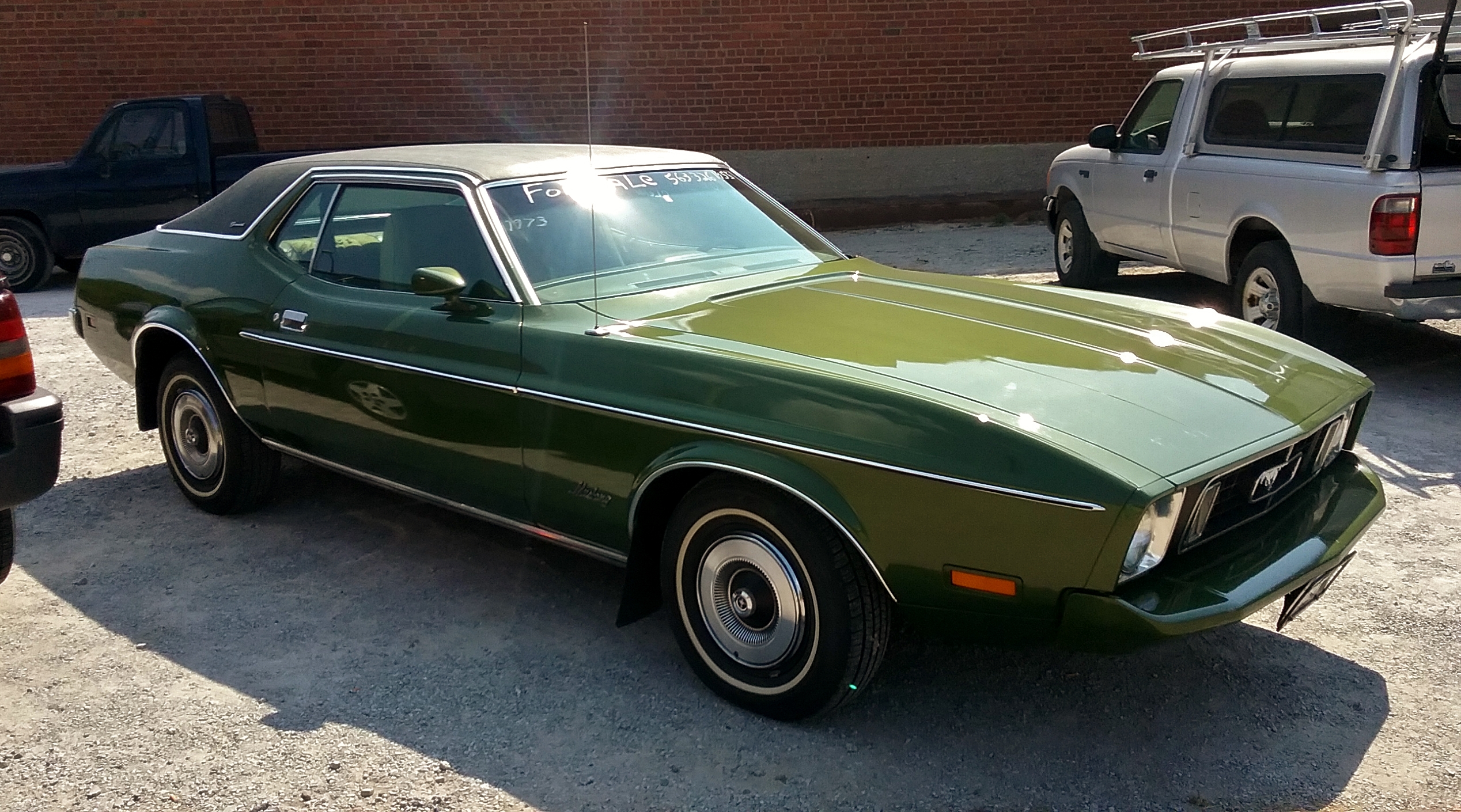
Say, remember the Mustang? Of course you do. Well…you remember the obvious ones, anyway. Shelby GT350. 1965 2+2 GT. Boss 302. Boss 429. All the usual suspects. But there are a lot of Mustangs out there that have been nearly elbowed off the stage, thanks to Resale Red, American Racing wheel-shod, phony-GT car show and cruise night impostors! In fact, should you mention certain Mustangs to those Foose-footed red Mustang owners, you may cause them to grow pale and run away: Mustang II! Mustang Grandé Mustang Ghia and Mustang L! Mustangs with six-cylinder engines and wheel covers! Augh! To those guys, it’s like throwing cloves of garlic at a vampire! No! No no no! All Mustangs were muscle cars dagnabit! And never mind that his ’67 Hardtop was originally Wimbledon White with dog-dish caps, green interior and six cylinder power! But let me tell you, I love the offbeat Mustangs, which were the majority of Mustangs back in the Sixties and Seventies. And the Broughamiest pony of them all is the subject of today’s post: the Grandé, available from 1969 to 1973.
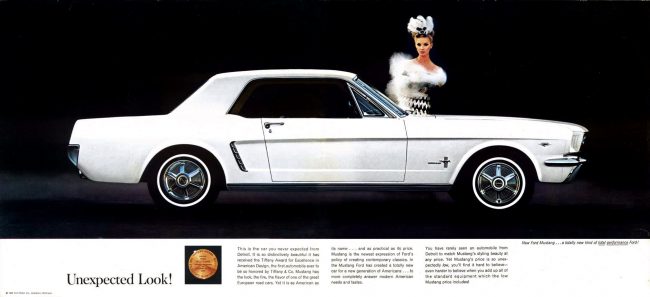
The Mustang: the Falcon that went to finishing school and came back better than ever, and nearly unrecognizable. Designed from the start to be eminently configurable, it could be equipped as anything from a basic inline-six, zero-option runabout to a thoroughbred V8 sprinter, and the available extras, colors and trim levels only expanded as the decade wore on. The 1967-68s got a bigger engine bay to accommodate big-block power, thanks to Bunkie Knudsen.
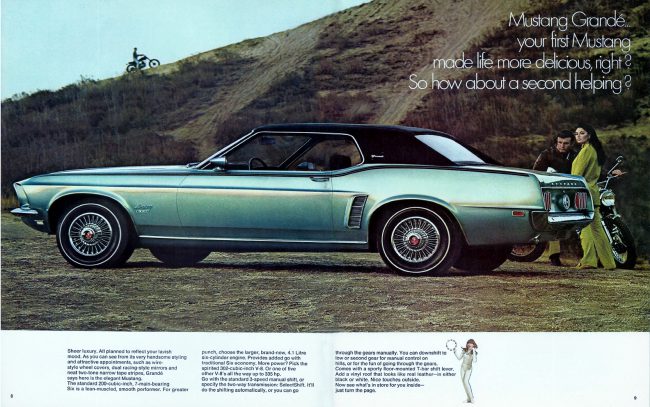
1969 delivered another restyling, adding length to its flanks. A luxury model, the Grandé, made its first appearance in Ford showrooms. And while all 1969 Mustangs appeared, well, grande, they were in fact only 3.8 inches longer than the ’68 models and rode the same 108″ wheelbase. The Mustang Grandé was the Mustang aping the Mercury Cougar for a change.

The Grandé was rather elegant, with its subtle metallic colors, notchback roofline, vinyl roof, full wheel covers, whitewalls and, of course, a suitably plush interior. The Grandé was priced about $200 above the basic Mustang hardtop.
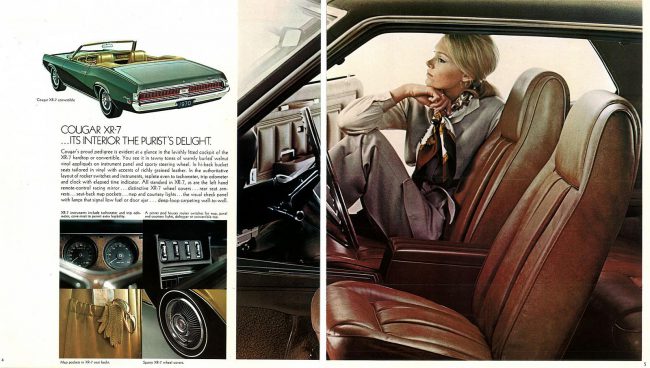
1970 Cougar XR-7
The Grandé was the Ford mothership coming back to an idea that first appeared at Lincoln-Mercury division: the Mercury Cougar XR-7. Meant as an upper-crust Mustang variant for L-M dealers, the Cougar was a nicely styled pony car, with its finer interior and Schick electric-razor grille and concealed headlamps.

1970 XR-7 hardtop
Poor Mercury: Perpetually moving between junior Lincoln and upper-crust Ford over the decades. They finally come up with something new for a change, a luxury pony car. Then not two years later, the Mustang cheerfully copies it! Yes, of course they’re corporate cousins, but the ’69 Grandé looks an awful lot like a knockoff of the Cougar, right down to the plush seats, roof line and chrome trim. At least the Cougar still set itself apart with its hidden headlights and full-width taillamps. But I digress…
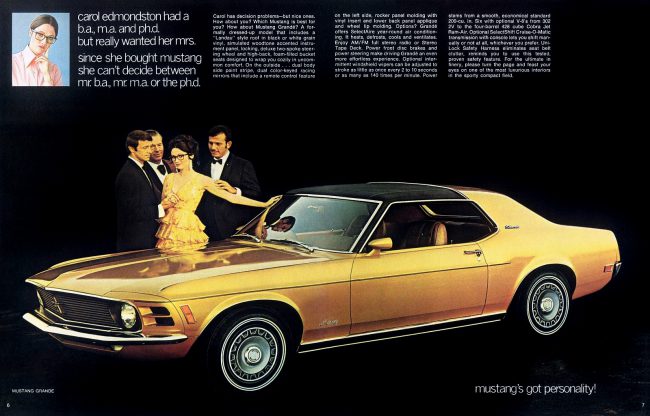
Now where was I? The ’69 Grandé sold 22,182 copies, not bad for a first-year model. It was a simple formula. Take a standard model, dress it up, add more chrome and a vinyl top, and presto! More profit! So naturally, the Grandé returned for ’70.

1970 Ford LTD Brougham
Ford was a natural at this, partially due to Lee Iacocca’s love of all things Brougham. It started with the LTD, then moved through the line: Ford F100 Ranger, Gran Torino, Thunderbird Landau. There were even Luxury Decor Groups for the Maverick and Pinto, for heaven’s sake! Despite a new vinyl canopy-roof option, Grandé sales were down, to the tune of 13,581 units. Perhaps that was due to the availability of more tantalizing Mustangs like the Boss 302 (my favorite Mustang), Boss 429 and Mach 1. By 1970 the writing was on the wall for muscle cars. Perhaps more folks wanted a Mach 1 or Boss for one last hurrah, rather than Grandé luxury.
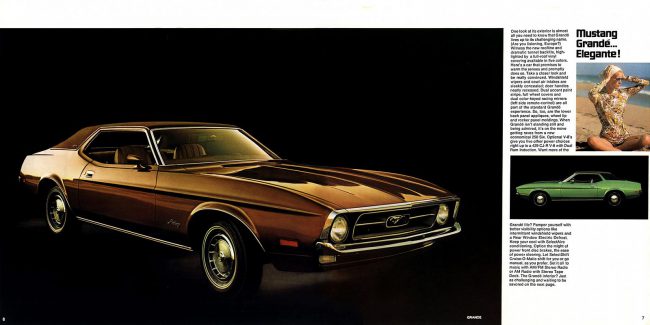
Things changed drastically for ’71. Compared to previous versions, the 1971 Mustang was a lead sled. The “classic” Mustang look had been replaced with a billiard table-size hood, smooth sides and flying buttress C-pillars on the hardtop, much like the ’68 Charger.
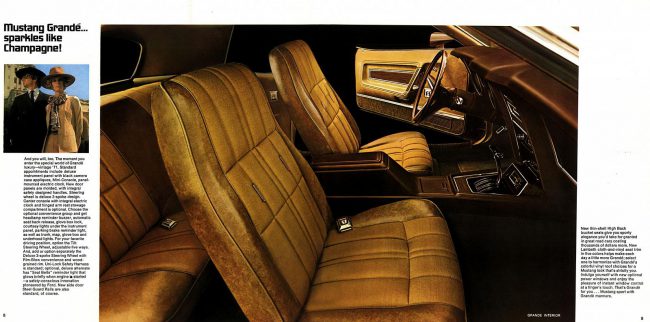
Yes, the ’71s were longer, lower and wider than any previous Mustang, but as with the ’69 model, the look was in large part an optical illusion; versus their predecessors, they had a wheelbase only one inch longer, and sported a mere 1/10th-inch more in overall length. But they looked so much bigger that to this day, people think they were mastodons vis-a-vis the 1965 version.
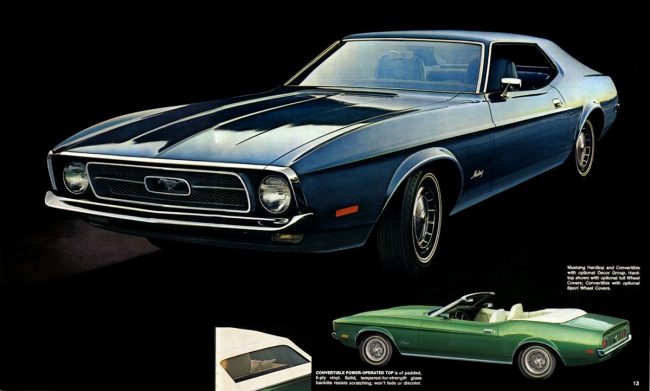
As expected, the hardtop, fastback and convertible all returned for ’71. Sadly, the legendary Boss 302 and Boss 429 had been dropped, although a new Boss 351 fastback offered partial compensation. In terms of power, everything from a 145-hp, 250 cu in six to a Ram Air, Super Cobra Jet 429 with 375 oh-so-understated horses was available. Six-cylinder Grandés started at $3,117, and V8s at $3,212.

You’d think Ford would have consulted a Spanish-to-English dictionary before bestowing “Grandé” nomenclature on these plush mini-T-Birds; in Spanish, “Grandé” means “large”, not “great” or “grand.” Unintentionally accurate, eh?
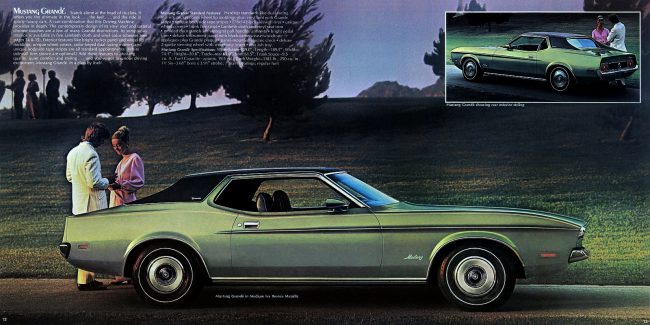
1972 Ford Mustang Grandé
1972 Mustangs were basically the same as the ’71s, though the Boss 351 said adieu.
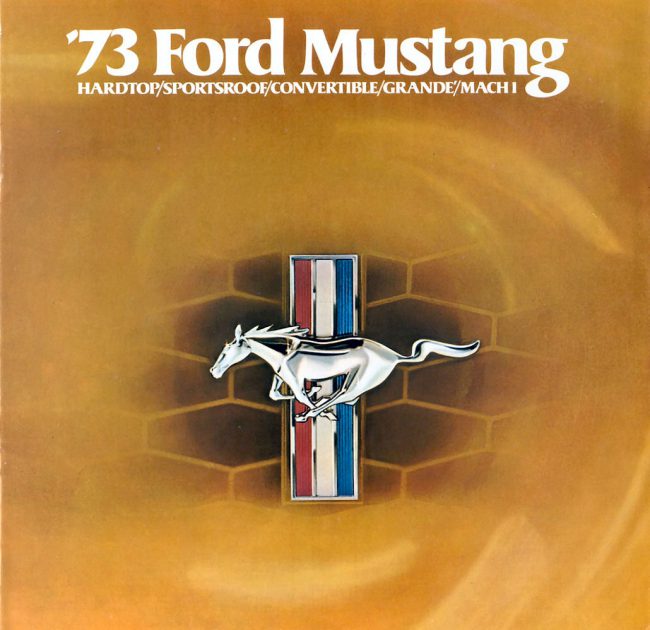
1973 Mustangs, like all 1973 cars sold in the United States, received a 5-mph front bumper. Unlike some other makes and models, however, it was not a gigantic chrome “park bench” or the ’72 bumper with honking huge bumper guards.
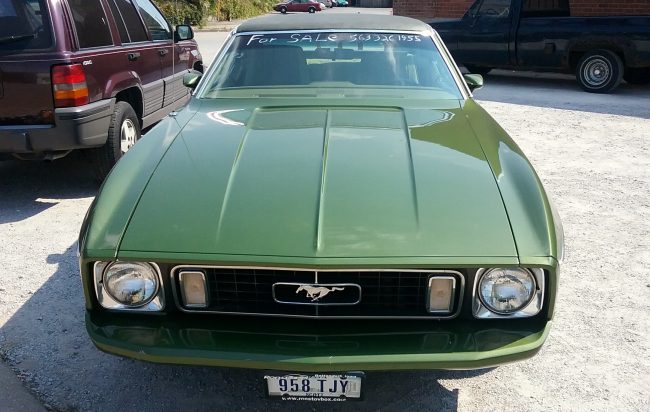
’73 Mustangs featured an integrated, color-keyed front bumper, which looked pretty good compared to how some other manufacturers were coping with the new bumper regulations.
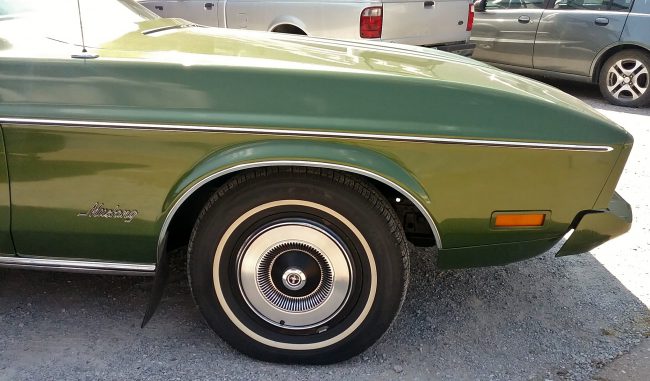
The 1973 Grandé had a 109″ wheelbase, overall length of 193.8″ and curb weight of 3,059 pounds. MSRP before options was $2,946. For comparison’s sake, a plain Jane ’73 Mustang hardtop had a base price of $2,760. And although these ’71-’73 Mustangs look awfully big compared to the original, it wasn’t quite as drastically enlarged as you may think.
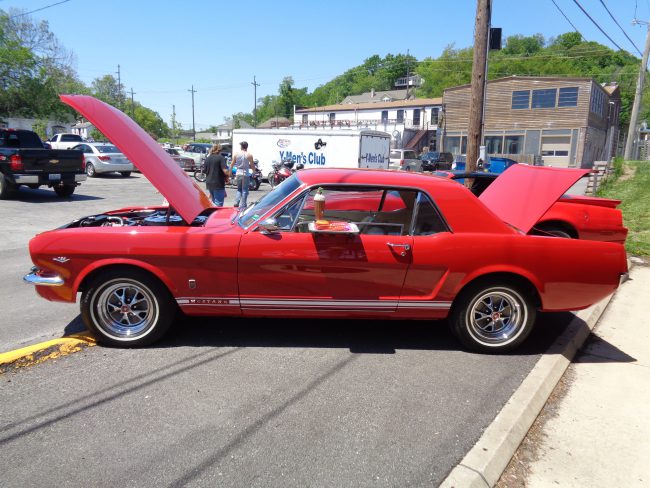
1965 Mustang GT at the 2017 Loafers Car Show in Hannibal, Missouri.
A 1965 Mustang, in comparison to the 1971-73 model, had a 108″ wheelbase, length of 181.6″, a curb weight of 2,583 and a base price of $2,372. So we’re talking about one inch of wheelbase, about a foot of extra length and about 300 pounds added. And the 1972 Mustang had a length of 189.51, so the extra 4″ on ’73s was due to the new 5-mph bumper.
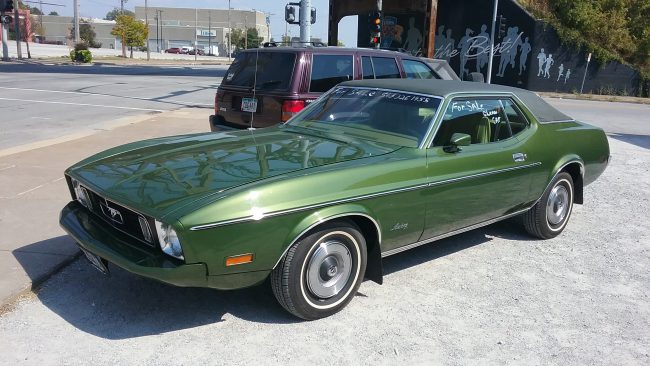
So it was not exactly a Cadillac Fleetwood Brougham, though it certainly looked much bigger, especially with that pool table-sized hood. And just for chuckles, the 2018 Mustang is 188″ long, with a 107.1″ wheelbase and curb weight of about 3500-3800 pounds. Even the new variant isn’t drastically different in its overall footprint!
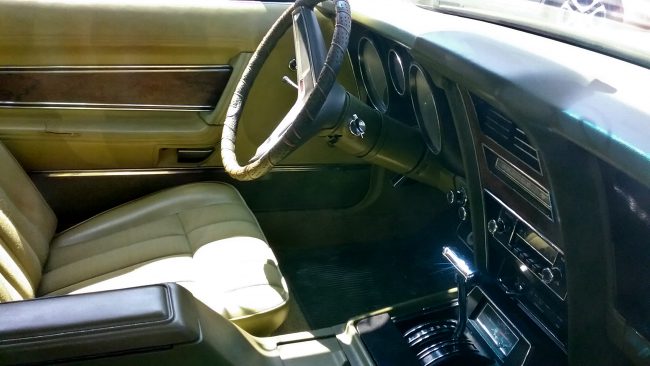
Whether you ordered your Mustang as a hardtop, convertible or fastback, or even as a Grandé, you got the same engine: a 250 CID inline six cylinder with 95 horsepower. But as was the case with pretty much every American car back then, you could easily option up some more oomph. In the Mustang’s case, you could get the ubiquitous 302 V8 with 136 bhp or go top drawer with the 351 V8, available in either 154 or 156 horsepower guises. And keep in mind that although those figures don’t sound so exciting in 2018, the two V8s certainly provided additional torque, compared to the Falcon/Maverick six.
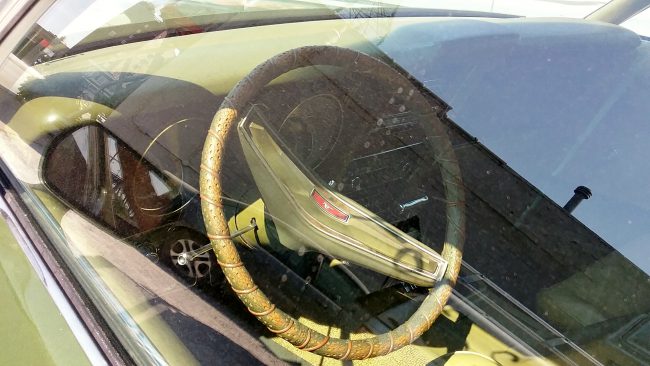
But I am certain that there were still many Mustangs coming off the assembly line with the base 250, and plenty without stripes, spoilers and Magnum 500 styled steel wheels. Plenty of plain white base hardtops with hubcaps and no A/C too. Even the Grandé itself was more of a mini-me Thunderbird than a high-horsepower bruiser. It was for people who wanted a little luxury and style, but without the price tag and big-car dimensions of the Thunderbird or LTD. Hey, it was 1973. The Boomers were growing up, starting their professional careers, and having kids. It was time for a little restraint, a little maturity.

And therein lies the Muscle Car Fallacy, to wit: Many, nay, most pony cars in the ’60s and early ’70s were not hot rods. Sure, high-test variants were available, but they were certainly in the minority. Most Chevelles were not SS396s, most Camaros were not Z/28s, and most Mustangs were not GTs, Boss 302s or Boss 429s. Thanks to well-off Boomers from the 1980s to the present day, and a surfeit of repro parts, Sadie the Secretary’s ’66 powder-blue 250-cube six-cylinder Mustang is today a bright red SCJ Mustang. Taken in its proper 1965-71 context, the Grandé was not all that unusual. And besides, what’s wrong with a little comfort?
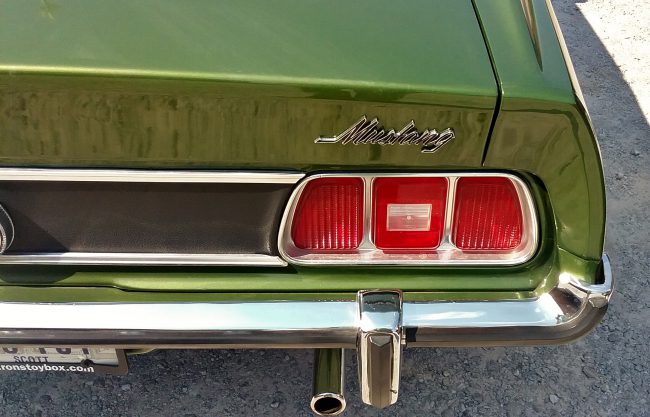
With that in mind, the Grande was actually a nice, plush boulevardier. Broughamy, yet sporty as well. No, it wasn’t a classic ’65 Mustang, but no one was going to mistake it for a Custom 500 or Biscayne either. To my eyes, this Mustang has some style–and clearly remains a Mustang with the characteristic long hood and short deck. The lines are clean and trim, at least when compared with the gun-slit windowed, used-bar-of-soap beige beigemist mid-sizers on the road today.
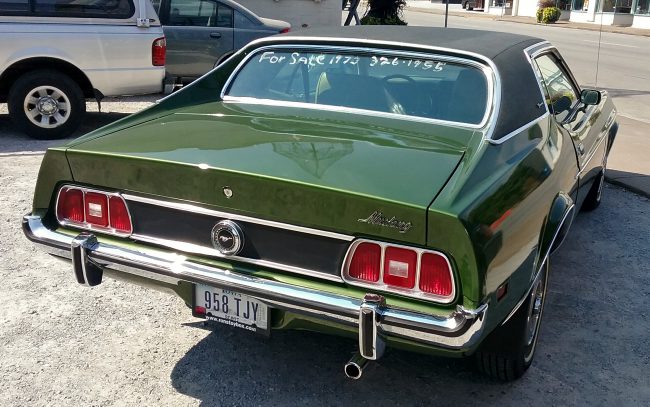
1971-73 Grandés received all the usual Mustang features, plus bright pedal pads, Deluxe cloth-and-vinyl, high-back buckets, Deluxe instrument panel and steering wheel, electric clock, special door panels with integral door pulls and armrests, dual paint accent stripes, color-keyed sport mirrors, bright rocker and wheel lip moldings, vinyl roof and more.

1973 Mustang hardtop
In addition to the previously mentioned range of available V8s, options included Cruise-O-Matic transmission, power front disc/rear drum brakes, power steering, power windows and a rear window defogger.

Annual Grandé sales for the 1971-73 period were 17,406, 18,045 and 25,274, respectively, a telling sign of the advancement Broughamage in America. Plush was in! And while both the Grandé and the zaftig Mustang would go away after ’73, the Brougham Mustang would carry on in Bristol fashion through the early Fox-body years, albeit as a Ghia, not a Grandé.
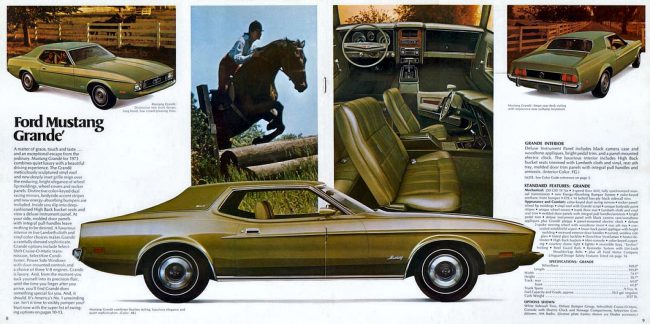
Ford was now trumpeting comfort and handling, not quarter-mile drama; rising insurance costs had seen to that. After ’73, the Grandé and the convertible were dropped; eventually, the convertible would return, but the Grandé would not.
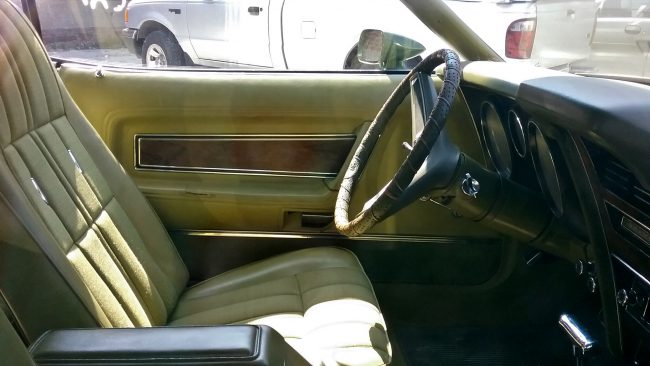
I spotted this most excellent green Grandé (Medium Green Metallic, according to the 1973 Ford color chart) in downtown Davenport last September. I was on my way somewhere, but upon noticing this rather uncommon FoMoCo product sitting off of Iowa Street, I immediately pulled over, parked and walked back to it.

It was in remarkably nice shape, from the paint to the sheetmetal to the upholstery. It was either a restoration or an amazingly well-preserved original. It was for sale too, though there was only a number and no price listed. It will make a nice cruise-night car/Sunday driver for someone. And I bet it will get a lot more attention at shows than the latest “restored” Resale Red ’65 faux-GT with made-in-China 289 emblems!
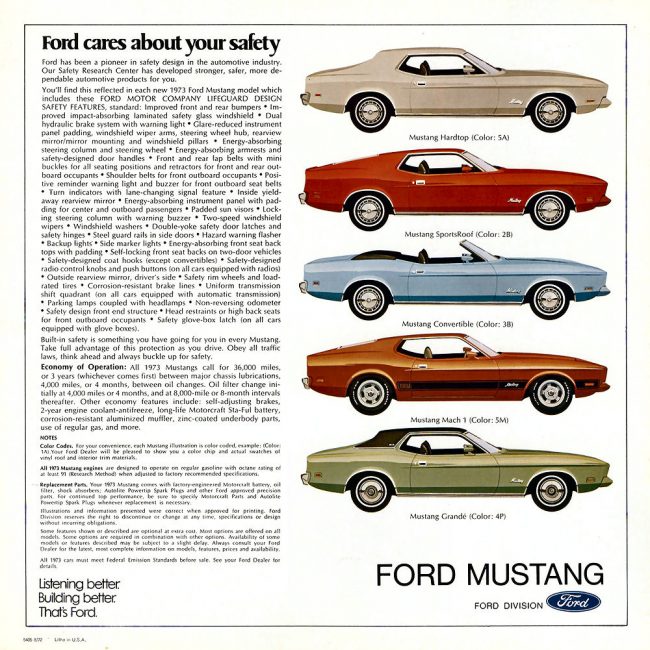
Yes, the Grandé was a kind of odd offshoot of the classic pony car. Luxury over sportiness, but not over-the-top Broughaminess like a Continental Mark IV. You don’t see these very often any more, not even at shows. Not even at Ford-centric shows. So spotting this Me Decade Mustang last autumn made my day!







12 Comments
I had the same steering wheel wrap back in the 70s except I actually took the time to stich it. Your photo car is/was for sale. I’d like to see what’s under that because it could be beat to hell. I’ve seen cars of that vintage with the plastic missing in sections with nothing but the steel rim showing.
Always found it odd that front bumper was color matched but the rear was chrome. Do it one way or the other but do it same way.
Peak Mustang for me would be a 1970 Boss 302. I’m a sucker for the front fender side light.
I think they only had to put the impact absorbing bumper on the front in 1973, and on the back in 74, but since the Mustang II came in 74 they probably just decided to keep the chrome rather than spend money on an unneeded (regulatory wise) change to a body on its last year. GM also did the same thing on the Corvette in 73, although the C3 body lived on until 82.
The worst thing about these Mustangs was the build and material quality – absolutely awful. They rattled like a piggy bank half full of pennies from new and got worse from there, and the vinyl seat and plastic door material cracked and split within 3-5 years of modest use. The Mustang II gets rightly lambasted, but it was actually a much more tightly put together car.
So, would a Mustang Grande sell today among the myriad versions available? Would paint, real high-end interior upgrades, and maybe an enhanced ordering/customization experience steal any sales from 4-series or similar customers? I’d like to see it!
Well, I drive a GT Premium and I have to say it’s a little Broughamy, in a modern way. It’s not that different to be honest.
I suppose you could use a higher quality leather in the interior and maybe add a few other touches to match the interior of a 4 series Bimmer but I don’t think it’s that far off as it is today.
Thanks for the trip, but those prices!?!
End. The. Fed.
The catalog picture of the green 72 in front of the grass field is stunning. The Idea of dressing up an otherwise pretty basic compact with an economical 6 or a modest V8 seems quite sensible and worthwhile. There were more young and young at heart single people who were not pressed for additional utility. What they did need was a way to express their style and success. To make them feel more like a Grande’ when they walk up to it at the end of a long day. Seems worth a few hundred extra.
Paul Niedermeyer hates these things so I think they are okay.
Great post, Tom. My BIL had one of these back in the early 80’s, a nasty putty color (not original, but who would pay for it?) with a brown interior. It was a pretty basic Grande, (maybe a Grand?) with either the six or the 302. Either way, it was not fast or particularly plush by any means.
As you noted, this shat all over the Cougar, of which I am a big fan, but until you mentioned it, I never noticed the similarity to the fuselage Charger. Long, flowing shapes, flying buttress C pillar… Maybe it was Lido’s way of getting even with Chrysler for stealing away some Mustang and Torino sales. Most likely it was all just part of the “Brougham all the things” campaign.
You get all of the good finds…
I was never a fan of the 71-73 coupes (Notchback? Tunnelback?). That body was designed as a “Sportsroof” first and it shows in the Coupe. The proportions on the Coupe/Grande always seemed off to me.
I have to admit, that is a very nice find there.
I had never really thought about these cars as a reaction to the ’68 Charger. I knew they had the tunnel back window, but just thought that was a fad of the time. Looking at it as a Charger clone, it is amazing how hard it would have have been to capture the Charger’s aura. I’m not as anti-grande-Mustang as many are, but it sure missed the target. People forget that there was actually a lot of good press for the Mustang II when it arrived, seeming like a return to the spirit of 1964.5 after the budget MKIII of 1971. I’ve thought of these cars as Kamm-backs, although perhaps as much because of the blackout trim panel as they actual tail treatment.
The market liked the Mustang II as well.
It was the right car at the right time, something that gets forgotten in the Boomer nostalgia regarding the originals of a decade earlier.